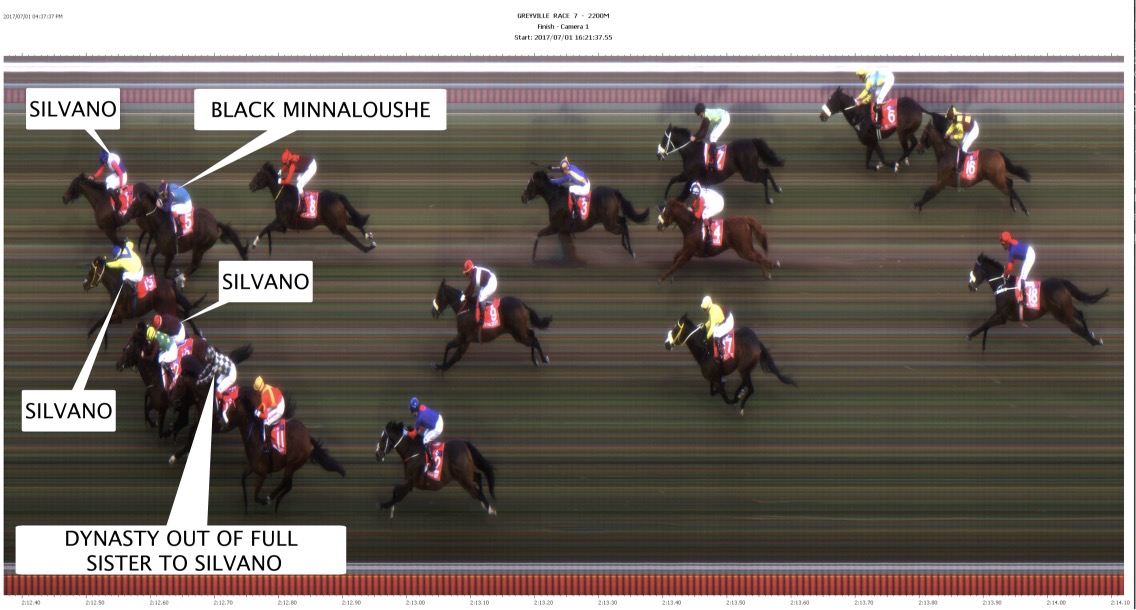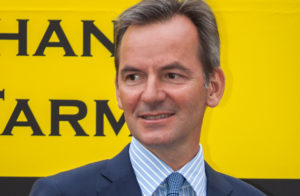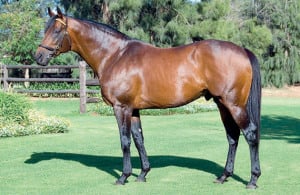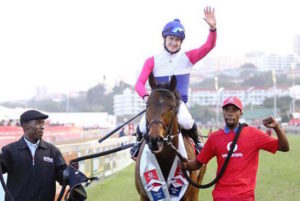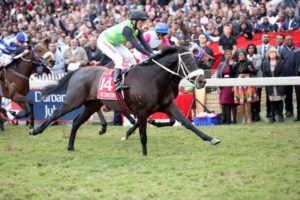One of my favourite things is my annual Durban July debrief with Charles Faull, historian and form analyst extraordinaire, who always comes up with some firm and interesting views on what we can learn from the outcome of the race.
As always, Charles’ comments were insightful and thought-provoking. “There were two standout achievements from the running of this year’s July,” says Charles, “and they are firstly that it is the sixth July winner to be produced by Mauritzfontein Stud and secondly ‘The Jacobs Factor’ as evidenced by the photo finish of this year’s race.”
The Jacobs Factor
“Fans of racing and breeding in South Africa will be eternally grateful for the contribution of Dr Andreas Jacobs to our studbook. Silvano has produced four July winners to date (Bold Silvano, Heavy Metal, Power King and Marinaresco) and just look at the result of this year’s July. It was won by a Silvano, from a Silvano. Dead-heating for 4th was a Silvano and a Black Minnaloushe and behind them was a Dynasty out of a full sister to Silvano. As we know, Silvano finished 1-2-3 in the 2015 Vodacom Durban July and now he’s produced this result. What an achievement by Andreas Jacobs and I’ve not seen it mentioned anywhere!”
“The contribution made to the local industry by Dr Andreas Jacobs and international industrialists of his kind cannot be overestimated or overstated,” he says emphatically. “The South African Thoroughbred breeding industry evolved as an adjunct to farming. Godfrey Gird once said you could take a third of your wool crop and buy a decent stallion prospect. Then American involvement and Arab petro-dollars sent bloodstock prices soaring, leaving SA Breeders and the weak Rand struggling to compete for worthwhile breeding stock. When international industrialists weighed in, they invested in bloodstock in a whole new way and raised the bar to a new level.”
“We are seeing this in Maine Chance with Dr Jacobs, Highlands Farms Stud, first via Graham Beck and now the Kieswetter family, La Plaisance Stud via Sabine Plattner, Varsfontein Stud via the Kalmansons, Mauritzfontein and Wilgerbosdrift via the Oppenheimer family, Lammerskraal via Mike Rattray and now Pieter Graaff, Summerhill via Mick Goss, Klawervlei via the Kosters and now Mayfair Speculators, Khaya Stables via Lady Laidlaw, Arc-en-Ciel via Shirley Pfeiffer, Drakenstein via the Ruperts, the Scott Bros, Avontuur via the Taberer family and Moutonshoek via Chris Gerber.”
“We owe a great debt of thanks to these people who have added enormous value to our stud book by investing in top quality stallions and mares through their love of racing. With regard to Dr Jacobs in particular, it is incredible that this great equestrian and racing family has chosen to invest in South African racing and I would like to say thank you, sir. Well done, and please continue.”
“Perhaps the greatest compliment and testament to Silvano is that he manages to dominate the sires list the way he does given the South African racing programme.”
Charles feels strongly that the fact South African racing regards the Durban July as a staying race is a misnomer. “In terms of the global breed this perception is totally incorrect. Students of breeding that have taken the time to study Franco Varola (Typology of the Racehorse), which was an upgrade to the original dosage principle of Lt Col. J J Vullier (Les Croisements Rationnels Dans La Race Pure), adviser to the Aga Khan, will know that Varola defines the aptitudes of the Thoroughbred – supported by facts and knowledge of the breed – into four main categories: Brilliant (1000-1400m), Intermediate (1200-2200m), Classic (2000-2600m) and Stout (2400-4200m). The great mistake made by SA racing is to treat the Intermediate range as being the all-important type for testing success in the breed. This is simply not true, because as Tesio taught us, the Thoroughbred exists because of a piece of wood at the end of a mile and a half race at Epsom.”
Why our Classics are not Classics
“A mile and a half is the most important classic distance,” continues Charles. “Consider such great stallions as Sadler’s Wells (King George VI and Queen Elizabeth Stakes), Galileo (Epsom Derby), Hyperion (Epsom Derby, St Leger), Nearco (Italian Derby, Gran Premio d’Italia, Gran Premio di Milano, Grand Prix de Paris), Buckpasser (Lawrence Realisation Stakes, Jockey Club Gold Cup) and A.P. Indy (Belmont Stakes) – the list is endless. Varola rightly teaches us that an overconcentration of speed on speed results in cheap speed. He also teaches us that Classic ability is no less than speed extended in time and we know the Classic racehorse only reaches full power towards the end of their 4yo season.”
“Now,” he says, warming to his story, “consider Silvano, Dr Jacobs’ greatest contribution to our stud book so far. This is a stallion created and developed by the Jacobs family at Fahrhof Stud and what strikes one when studying Silvano’s pedigree is it is pure German Classicity. They bred Silvano (winner of the Grosser Preis Der Wirtschaft, the Singapore Cup, the Audemars Piguet QEII Cup and the Arlington Million). They bred his sire Lomitas who was a 2400m specialist (winner of Grosser Preis von Baden (2400m), Preis von Europa (2400m), Preis der Berliner Bank (2400m), German champion 2yo and 3yo, 1991 Horse of the Year and Champion Freshman sire). They bred Lomitas’ dam, La Colorada (a German champion race filly) and the family all the way back to the mighty Surumu (winner of the German Derby, Union Rennen, and six times Champion Sire and Champion Broodmare Sire).”
They say a stallion’s pedigree tells you what they could be, their performance tells you what they should be and their progeny tells you what they are, so let’s take a look at Silvano’s record at stud. “A perusal of his detailed foal report as published by ARO leaves absolutely no doubt that Silvano is a predominantly Classic / Stout stallion. In his very first SA crop, he produced SA Oaks winner, Happy Spirit as well as SA Derby winner, Kings Gambit,” continues Charles.
“What does that tell us about Marinaresco? He’s by Silvano out of a Fort Wood mare (also a predominantly Classic influence) so was surely bred to be typical of the Classic (2000-2600m) type.”
“Prior to this year’s July, he had had 1 start beyond 2000m which was last year’s July when he was the equivalent of a teenager. He came back as a 4yo with one or two eye catching speed performances in the Green Point and Drill Hall Stakes, however, it must be apparent to all form analysts that his ‘disappointing’ runs in the Queen’s Plate, Met and Gold Challenge can be ascribed to the fact here is a pure Classic horse being kept to Intermediate distances because of our totally deficient provision for true Classic and stout racehorses. Marinaresco’s run in this year’s July was his first test as a fully muscularly mature racehorse and as a Classic type, 2200m would have been at the very bottom of his ideal range.”
Rating
“In my opinion, his performance level in this year’s race reflected an improvement of 14lbs over his performance when 2nd to The Conglomerate last year. How often haven’t we seen top 3yo’s improve by 14lbs or more from three to four years of age, e.g. Sea Cottage, Yataghan, Politician, London News, Futura, etc. Just where the official WFA scale gets its figure of 4lbs WFA progression for 3yo’s in the July, is a mystery. We will see just how much Al Sahem, Edict of Nantes and Horizon improve vis a vis Marinaresco in the future.”
“There is little doubt in my mind this horse will go 2 miles with the best and in the future it would be great to see him race at WFA over the true classic distance of 2400m. Unfortunately, unlike every other turf country in the world, there isn’t a single major WFA race over a mile and a half in SA. It simply doesn’t exist!”
“In drawing attention here to the lack of top class properly endowed one and a half mile races in the country, like Maine Chance Farms, we find another great breeding establishment in Drakenstein Stud facing a future in which their Ascot Gold Cup producer, Duke of Marmalade, also faces seeing his progeny shoe-horned into an intermediate mould.”
“This absence of races in respect of Classic distances in our programme is a major problem. Who wants to watch 1400m – 1600m races time and again? All we are seeing is extended sprints. It’s boring! Races like the Epsom Derby, the Irish Derby, the King George, the Arc – these are races which not only produce great horses, but great tactical riding, which you only see at a mile and a half – not dashes. What happened to scheduling a proportion of longer races on every card?”
“The Bloodhorse published an article titled, ‘Real Men Don’t Eat Quiche and Real Horses Stay A Mile and A Half.’ Don’t we need a R5 million mile and a half WFA race to establish just who is the best horse in the country? Rest assured Legal Eagle (SA Derby winner) will turn up for that one!”



